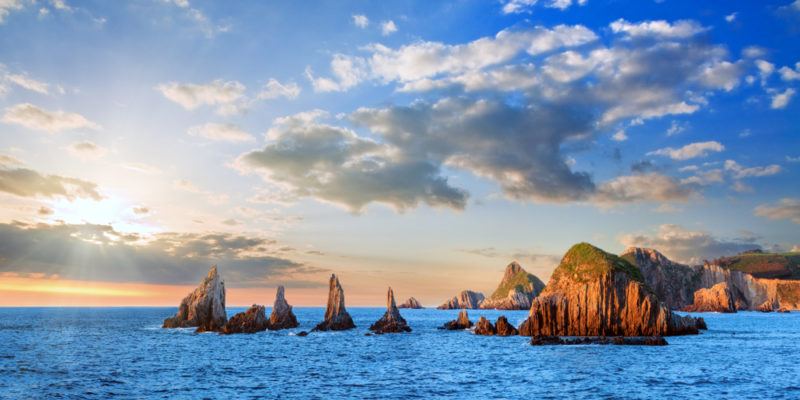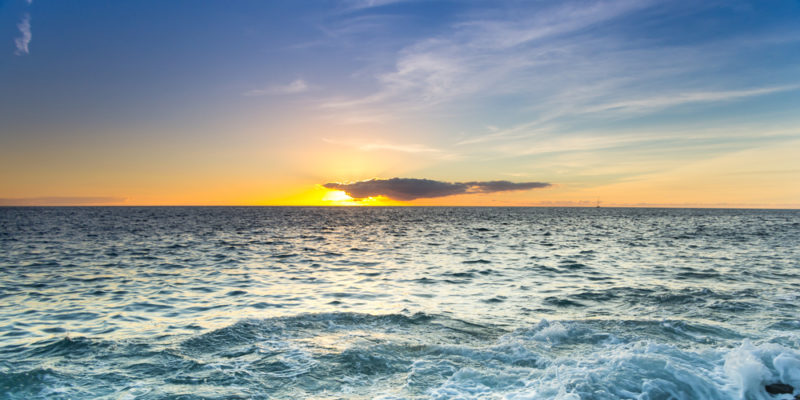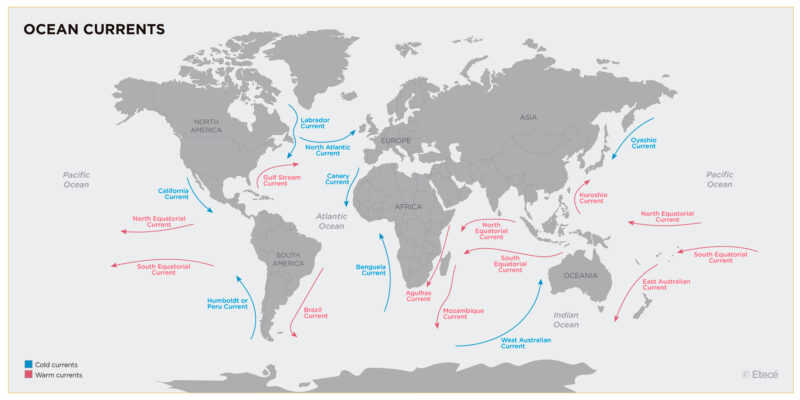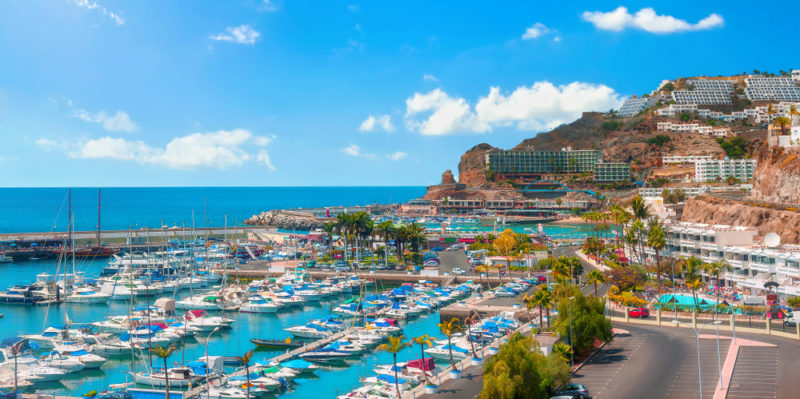Table of Contents
We explore the Atlantic Ocean, and discuss its location and extent. In addition, we describe its characteristics, ocean currents, and more.

What is the Atlantic Ocean?
The Atlantic Ocean is the body of salt water that separates the Americas from Europe and Africa. It formed 200 million years ago, following the breakup of the supercontinent Pangea.
The Atlantic is the second-largest ocean in the world. Covering approximately 41 million square miles (106.4 million km2), it accounts for 20 % of the Earth's total area. It lies between the landmass of the Americas to the west and that of Africa and Europe to the east.
For centuries, the prevailing idea in Europe, Asia, and Africa was that this ocean marked the end of the world. However, in 1492, the Genoese navigator Christopher Columbus sailed across its waters in search of a trade route that would allow him to reach Asia, reaching the American continent.
Subsequently, during the colonial period, the Atlantic Ocean became an important trade route between the Americas, Europe, and Africa. Across the Atlantic, the riches extracted from the Americas by Europeans were moved, as well as the slaves transported from Africa to work in mines and plantations. Likewise, during the 19th and 20th centuries, it was the route taken by millions of European immigrants who left their countries for the Americas.
Today, the Atlantic is one of the busiest oceans in the world in terms of commerce. It is of vital economic importance for trade between Europe and the Americas, with oil extraction, fish farming, tourism, and trade among the largest on the planet.
The name Atlantic comes from the Greek deity Atlas, the Titan who holds the heavens on his shoulders as punishment imposed by Zeus. The ancient Greeks thought the world ended at the Pillars of Hercules, which mark the end of the Mediterranean Sea, and believed that the Atlantic Ocean was a giant river encircling the world.
- See also: Indian Ocean
Atlantic Ocean facts
The main characteristics of the Atlantic Ocean are:
- It is the second-largest ocean in the world.
- It has an area of 41 million square miles (106.4 million km2).
- It lies between the Americas, Africa, and Europe.
- It formed 200 million years ago, with the breakup of the supercontinent Pangea.
- It contains an extensive underwater volcanic belt in its depths known as the Mid-Atlantic Ridge.
- Its climate varies as it stretches away from warmer equatorial regions.
- It is home to a wide diversity of aquatic species.
How was the Atlantic Ocean formed?

200 million years ago, a single supercontinent called Pangea existed, made up of all the present-day continents combined. The only ocean that existed at the time was Panthalassa, which surrounded Pangea. When the continents began to break apart, other oceans were formed. The separation of Africa, Europe, and the Americas caused the Atlantic Ocean to form.
Over geologic time, the continents continued to drift apart, and the Atlantic Ocean spread. The spreading rate of the Americas from Europe and Africa is approximately 3 centimeters per year.
Topography of the ocean floor
The Mid-Atlantic Ridge is an underground volcanic mountain range located in the middle of the Atlantic Ocean. It runs north-south for over 9,950 miles (16,000 km) stretching from Iceland to Antarctica. It formed as a result of the separation of the North American Plate from the Eurasian and African plates.
This ridge is a site of massive underwater volcanic activity, and although these eruptions rarely pose a risk to human populations, they are important for their geological significance. The lava from volcanic eruptions quickly cools and solidifies upon contact with water, forming oceanic crust.
In certain areas, these volcanoes are so high that they rise above sea level forming islands in the middle of the ocean. Among the major islands are Iceland and the Azores in the Northern Atlantic, and Ascension Island and Saint Helena in the South Atlantic.
Atlantic Ocean climate
Due to its vast extent, the Atlantic Ocean stretches across a wide variety of climates. In equatorial and tropical regions, the climate is warm and rainy, and ocean water is warmer. As the distance from the equator increases, the climate becomes cooler and the water temperature drops.
Extreme weather events occur in the Atlantic Ocean. In waters near the Gulf of Mexico, large tropical storms called hurricanes form, particularly affecting Central America, Mexico, and the Southern United States.
Flora and fauna of the Atlantic Ocean
Marine flora in the Atlantic, as in all oceans, is characterized by the presence of phytoplankton, which are microorganisms capable of photosynthesis constituting the base of the marine food chain.
In terms of fauna, it is populated by fish of various sizes and large predators such as sharks and killer whales. In deep and abyssal waters, life forms exist that have evolved to withstand water pressure, darkness, and low temperatures. Some species even possess bioluminescent organs that allow them to communicate, defend against predators, and find food in low-light conditions.
The waters near the poles, in turn, are home to marine life adapted to the low-temperature, icy environment, with species such as seals, walruses, penguins, and whales.
Atlantic Ocean currents

Differences in water temperature cause ocean currents to form. These are water flows that are in continuous movement within the oceans. The main ocean currents that circulate through the Atlantic Ocean are:
Cold currents:
- North Atlantic Current. It flows from Newfoundland in Canada toward Western Europe.
- Canary Current. It flows southward from the Canary Islands to northwest Africa.
- Labrador Current. It flows southward from the Arctic along the coast of Canada.
- Benguela Current. It flows northward from Antarctica along the west coast of Africa.
Warm currents:
- Gulf Stream Current. It originates in the Gulf of Mexico and flows northeastward, affecting the East Coast of the United States and northern Europe.
- Brazil Current. It flows southward from northeastern Brazil along the coast of South America.
Countries bordering the Atlantic Ocean
The countries bordering the Atlantic Ocean lie in the Americas, Africa, and Europe.
| The Americas | Argentina, Bahamas, Brazil, Canada, Cuba, Puerto Rico, Dominican Republic, United States, Guyana, French Guiana, Haiti, Suriname, Trinidad and Tobago, Uruguay, Venezuela, and other countries in the Caribbean Sea and the Gulf of Mexico: Antigua and Barbuda, Barbados, Belize, Colombia, Costa Rica, Dominica, Grenada, Guatemala, Honduras, Jamaica, Mexico, Nicaragua. |
| Africa | South Africa, Angola, Benin, Cameroon, Cape Verde, Ivory Coast, Ghana, Gambia, Guinea, Gabon, Guinea-Bissau, Equatorial Guinea, Liberia, Morocco, Mauritania, Namibia, Nigeria, Republic of the Congo, Democratic Republic of the Congo, Sao Tome and Principe, Senegal, Sierra Leone, Togo, and other African countries in the Mediterranean: Algeria, Egypt, Libya, Tunisia. |
| Europe | Spain, France, United Kingdom, Portugal, Ireland, Iceland, Norway, and other Baltic Sea countries: Germany, Belgium, Denmark, Estonia, Finland, Sweden, Latvia, Lithuania, Netherlands, Poland, Russia; and other Mediterranean countries: Albania, Bosnia and Herzegovina, Cyprus, Northern Cyprus, Croatia, Slovenia, Greece, Italy, Malta, Monaco, Montenegro. |
Atlantic Ocean islands

The Atlantic Ocean is home to a large number of islands:
- The Svalbard archipelago, in the Norwegian Sea.
- Scandinavian islands, off the coasts of Norway and Sweden.
- Islands in the Baltic Sea, starting in the Danish straits.
- Islands off the coast of mainland Europe, from Jutland to the English Channel.
- The British Isles, including the United Kingdom and Ireland.
- Islands off the Atlantic Coast of France, Spain and Portugal, stretching up to the Strait of Gibraltar.
- Mediterranean islands, including Sicily, Sardinia, Cyprus, Corsica, Mallorca, Crete, Rhodes, and Lesbos, among others.
- Islands off the coast of Africa, such as the Canary Islands and the Azores.
- Islands in South America, such as Trinidad and Tobago.
- Caribbean Islands, including Margarita Island, Hispaniola, Cuba, and Puerto Rico, among others.
- Gulf Coast Islands, such as Isla Pérez and the Florida Keys.
The Bermuda Triangle is a region in the Atlantic Ocean located between the islands of Bermuda, Puerto Rico, and Miami. It gained international notoriety due to a series of incidents and disappearances of ships and airplanes that took place there over time. Various hypotheses have been proposed to explain these phenomena, ranging from climate-related and magnetic issues to supernatural theories and paranormal phenomena.
Pollution in the Atlantic Ocean
Pollution in the Atlantic Ocean has been a growing concern and a subject of study within the environmental and scientific communities over the past few decades. The degradation of the marine ecosystem includes chemical and plastic pollution, as well as pollution from oil extraction.
Chemical pollution
Chemical pollution is caused by the discharge of toxic chemical substances such as heavy metals and industrial products. These pollutants reach the ocean through activities including agriculture, mining, and industry. Exposure to these chemicals may have serious impacts on marine life and human health.
Plastic pollution
The accumulation of plastics in the Atlantic Ocean is a growing problem. Plastic debris, from microplastics to larger objects, decomposes very slowly in the ocean ecosystem. Two major "garbage patches" exist, a larger one in the North Atlantic and a smaller one in the South Atlantic. These are massive accumulations of garbage floating on the water, which may be millions of square miles in size.
Oil drilling pollution
Oil extraction on the continental shelves of the Atlantic Ocean are also a major source of pollution. These activities are carried out in the shallower parts of the ocean closer to the coastlines. Oil spills and the release of chemicals related to the extraction and transportation of oil can have detrimental effects on marine ecosystems and wildlife. These incidents cause long-term damage to marine habitats, biodiversity, and human health.
Atlantis
Atlantis is a legendary island of mythical origin mentioned by the Greek philosopher Plato in his dialogues Timaeus and Critias. According to Plato, Atlantis was an advanced and powerful civilization that existed thousands of years ago, and which sank into the Atlantic Ocean following a cataclysm.
There has been much speculation and many theories have been proposed about the true existence and location of Atlantis. However, there is no firm archaeological evidence to support its existence, making it a mythical legend rather than an actual historical civilization.
Explore next:
Was this information useful to you?
Yes NoThank you for visiting us :)